Economic Stability Analysis: Business and Australian Economy
VerifiedAdded on 2020/03/23
|10
|1423
|41
Report
AI Summary
This report provides a comprehensive analysis of economic stability, with a specific focus on the Australian economy. It begins by defining stability and examining how it is maintained through price mechanisms in individual markets. The report then delves into macroeconomic analysis, exploring aggregate demand and aggregate supply to determine equilibrium levels of income and price. Furthermore, it investigates the role of government policy instruments, including fiscal and monetary policies, in maintaining economic stability. A detailed analysis of the Australian economy follows, evaluating key indicators such as GDP, inflation, and unemployment over the past decade. The report concludes by discussing the policy framework and stabilization instruments employed by the Australian government to address economic fluctuations, including automatic and discretionary stabilizers. The report uses figures and statistics to support the analysis and provides references for further reading.
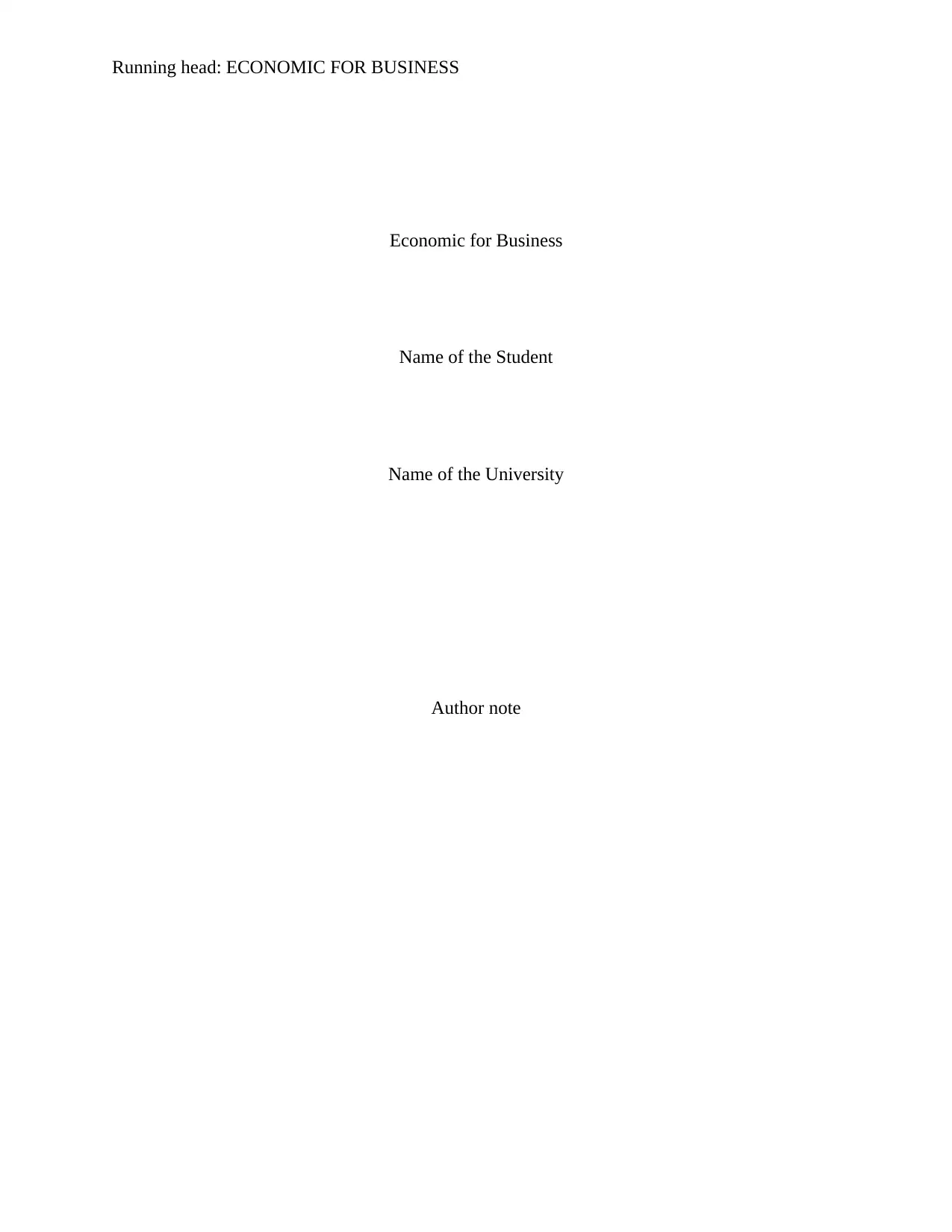
Running head: ECONOMIC FOR BUSINESS
Economic for Business
Name of the Student
Name of the University
Author note
Economic for Business
Name of the Student
Name of the University
Author note
Paraphrase This Document
Need a fresh take? Get an instant paraphrase of this document with our AI Paraphraser
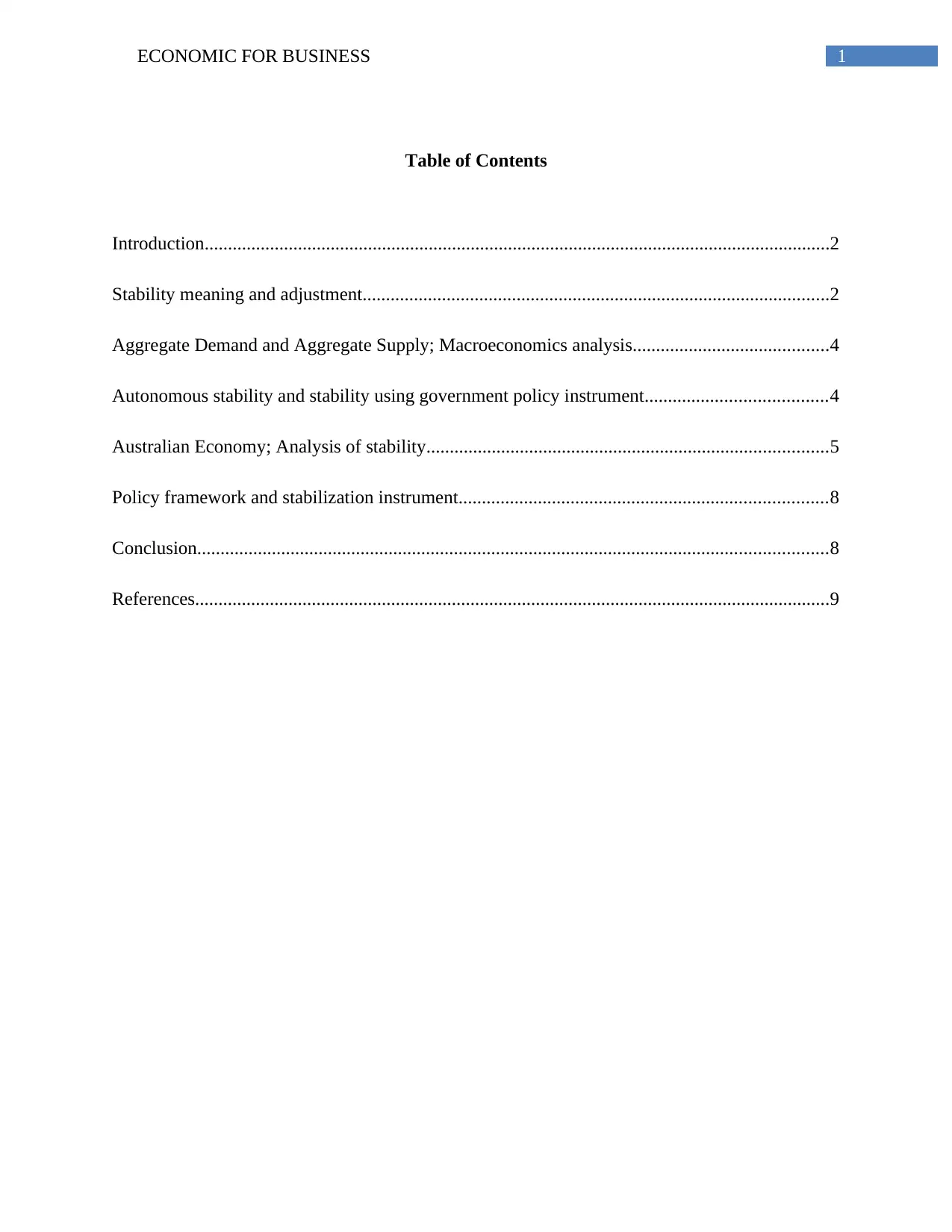
1ECONOMIC FOR BUSINESS
Table of Contents
Introduction......................................................................................................................................2
Stability meaning and adjustment....................................................................................................2
Aggregate Demand and Aggregate Supply; Macroeconomics analysis..........................................4
Autonomous stability and stability using government policy instrument.......................................4
Australian Economy; Analysis of stability......................................................................................5
Policy framework and stabilization instrument...............................................................................8
Conclusion.......................................................................................................................................8
References........................................................................................................................................9
Table of Contents
Introduction......................................................................................................................................2
Stability meaning and adjustment....................................................................................................2
Aggregate Demand and Aggregate Supply; Macroeconomics analysis..........................................4
Autonomous stability and stability using government policy instrument.......................................4
Australian Economy; Analysis of stability......................................................................................5
Policy framework and stabilization instrument...............................................................................8
Conclusion.......................................................................................................................................8
References........................................................................................................................................9
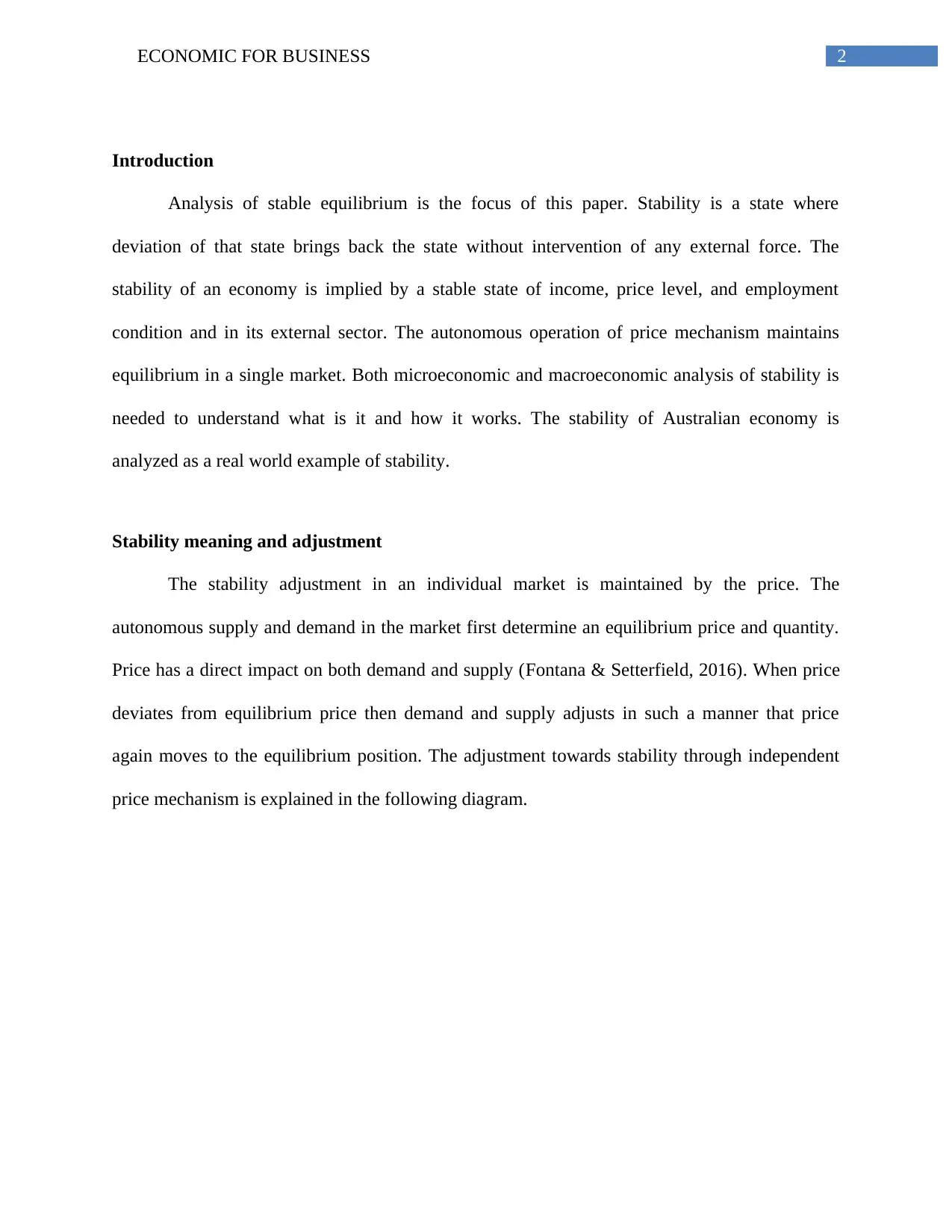
2ECONOMIC FOR BUSINESS
Introduction
Analysis of stable equilibrium is the focus of this paper. Stability is a state where
deviation of that state brings back the state without intervention of any external force. The
stability of an economy is implied by a stable state of income, price level, and employment
condition and in its external sector. The autonomous operation of price mechanism maintains
equilibrium in a single market. Both microeconomic and macroeconomic analysis of stability is
needed to understand what is it and how it works. The stability of Australian economy is
analyzed as a real world example of stability.
Stability meaning and adjustment
The stability adjustment in an individual market is maintained by the price. The
autonomous supply and demand in the market first determine an equilibrium price and quantity.
Price has a direct impact on both demand and supply (Fontana & Setterfield, 2016). When price
deviates from equilibrium price then demand and supply adjusts in such a manner that price
again moves to the equilibrium position. The adjustment towards stability through independent
price mechanism is explained in the following diagram.
Introduction
Analysis of stable equilibrium is the focus of this paper. Stability is a state where
deviation of that state brings back the state without intervention of any external force. The
stability of an economy is implied by a stable state of income, price level, and employment
condition and in its external sector. The autonomous operation of price mechanism maintains
equilibrium in a single market. Both microeconomic and macroeconomic analysis of stability is
needed to understand what is it and how it works. The stability of Australian economy is
analyzed as a real world example of stability.
Stability meaning and adjustment
The stability adjustment in an individual market is maintained by the price. The
autonomous supply and demand in the market first determine an equilibrium price and quantity.
Price has a direct impact on both demand and supply (Fontana & Setterfield, 2016). When price
deviates from equilibrium price then demand and supply adjusts in such a manner that price
again moves to the equilibrium position. The adjustment towards stability through independent
price mechanism is explained in the following diagram.
⊘ This is a preview!⊘
Do you want full access?
Subscribe today to unlock all pages.

Trusted by 1+ million students worldwide
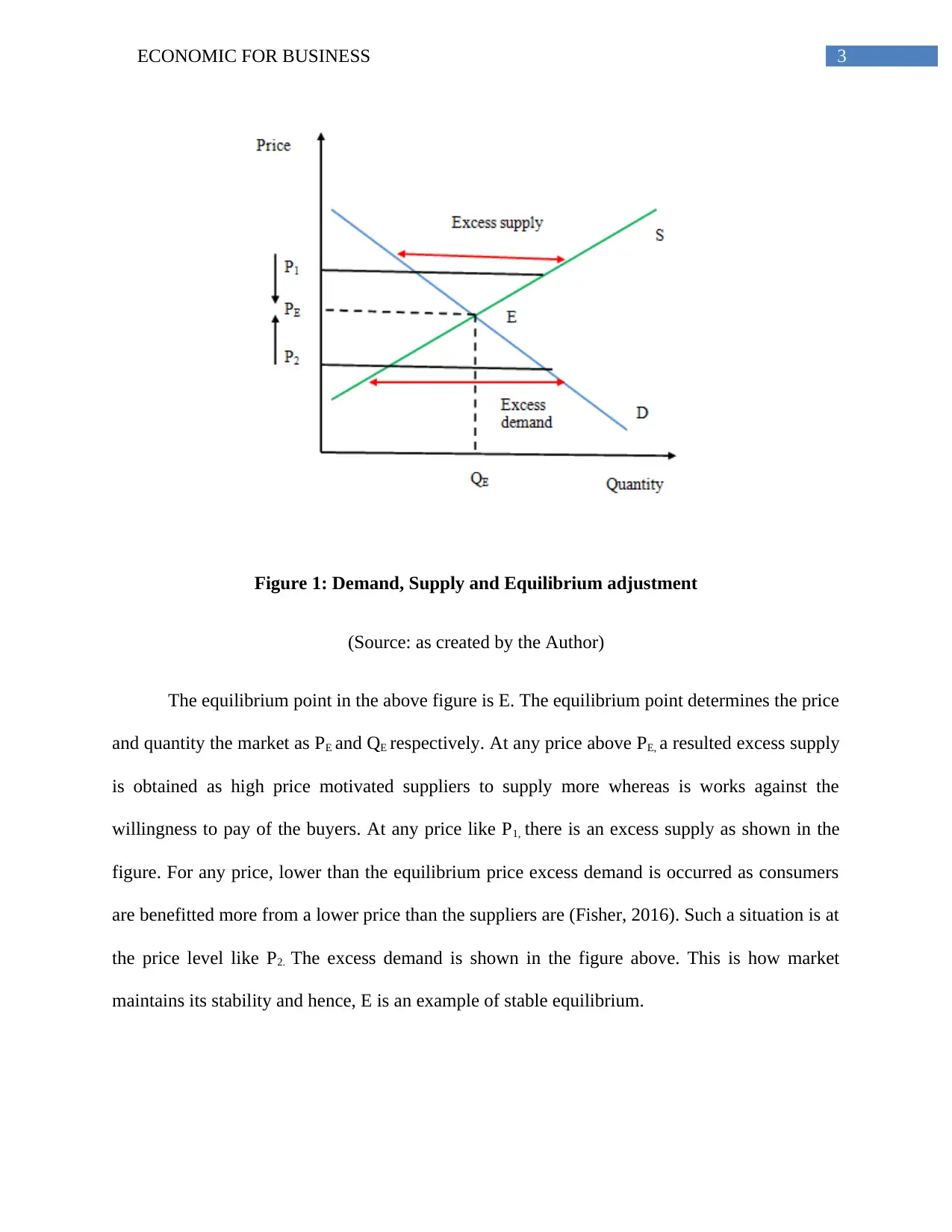
3ECONOMIC FOR BUSINESS
Figure 1: Demand, Supply and Equilibrium adjustment
(Source: as created by the Author)
The equilibrium point in the above figure is E. The equilibrium point determines the price
and quantity the market as PE and QE respectively. At any price above PE, a resulted excess supply
is obtained as high price motivated suppliers to supply more whereas is works against the
willingness to pay of the buyers. At any price like P1, there is an excess supply as shown in the
figure. For any price, lower than the equilibrium price excess demand is occurred as consumers
are benefitted more from a lower price than the suppliers are (Fisher, 2016). Such a situation is at
the price level like P2. The excess demand is shown in the figure above. This is how market
maintains its stability and hence, E is an example of stable equilibrium.
Figure 1: Demand, Supply and Equilibrium adjustment
(Source: as created by the Author)
The equilibrium point in the above figure is E. The equilibrium point determines the price
and quantity the market as PE and QE respectively. At any price above PE, a resulted excess supply
is obtained as high price motivated suppliers to supply more whereas is works against the
willingness to pay of the buyers. At any price like P1, there is an excess supply as shown in the
figure. For any price, lower than the equilibrium price excess demand is occurred as consumers
are benefitted more from a lower price than the suppliers are (Fisher, 2016). Such a situation is at
the price level like P2. The excess demand is shown in the figure above. This is how market
maintains its stability and hence, E is an example of stable equilibrium.
Paraphrase This Document
Need a fresh take? Get an instant paraphrase of this document with our AI Paraphraser
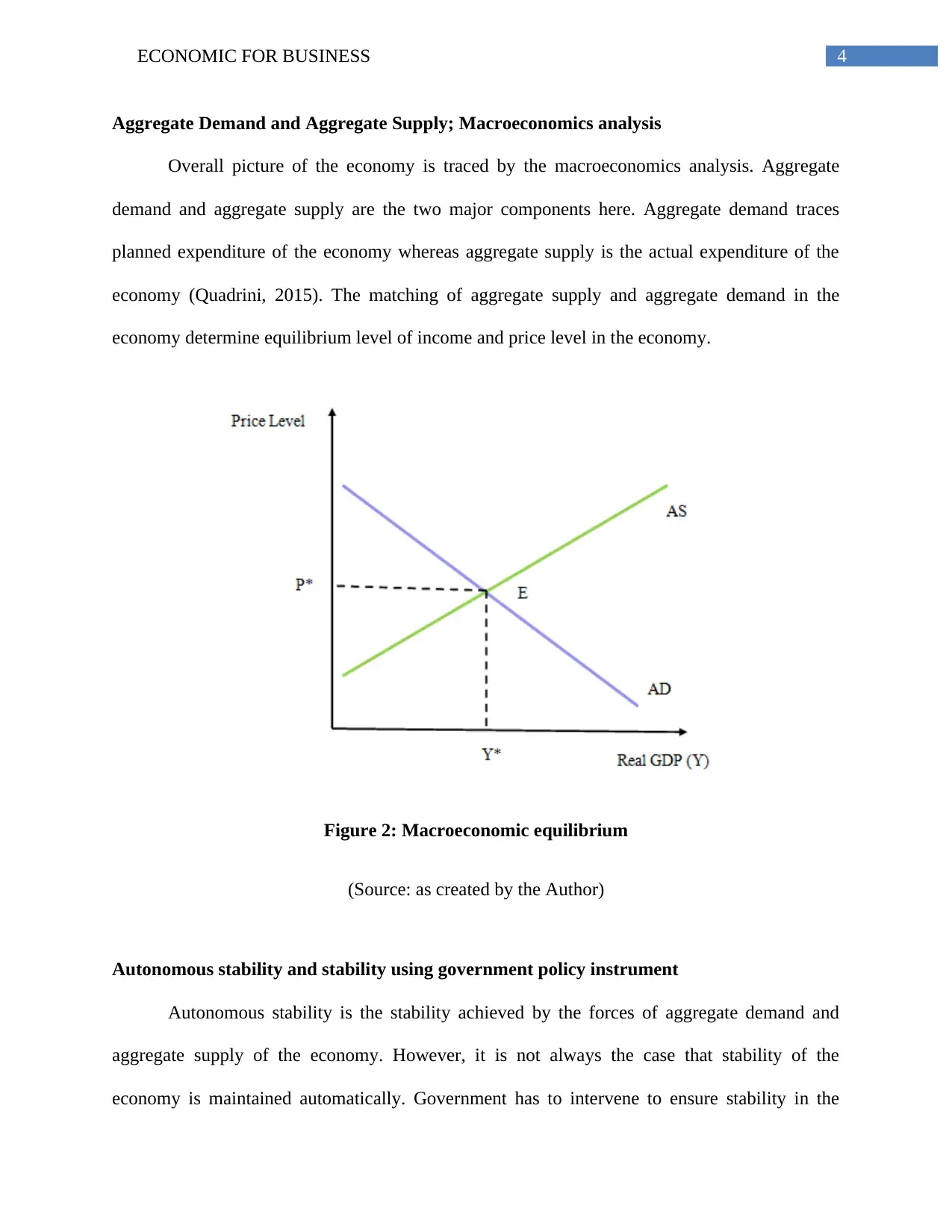
4ECONOMIC FOR BUSINESS
Aggregate Demand and Aggregate Supply; Macroeconomics analysis
Overall picture of the economy is traced by the macroeconomics analysis. Aggregate
demand and aggregate supply are the two major components here. Aggregate demand traces
planned expenditure of the economy whereas aggregate supply is the actual expenditure of the
economy (Quadrini, 2015). The matching of aggregate supply and aggregate demand in the
economy determine equilibrium level of income and price level in the economy.
Figure 2: Macroeconomic equilibrium
(Source: as created by the Author)
Autonomous stability and stability using government policy instrument
Autonomous stability is the stability achieved by the forces of aggregate demand and
aggregate supply of the economy. However, it is not always the case that stability of the
economy is maintained automatically. Government has to intervene to ensure stability in the
Aggregate Demand and Aggregate Supply; Macroeconomics analysis
Overall picture of the economy is traced by the macroeconomics analysis. Aggregate
demand and aggregate supply are the two major components here. Aggregate demand traces
planned expenditure of the economy whereas aggregate supply is the actual expenditure of the
economy (Quadrini, 2015). The matching of aggregate supply and aggregate demand in the
economy determine equilibrium level of income and price level in the economy.
Figure 2: Macroeconomic equilibrium
(Source: as created by the Author)
Autonomous stability and stability using government policy instrument
Autonomous stability is the stability achieved by the forces of aggregate demand and
aggregate supply of the economy. However, it is not always the case that stability of the
economy is maintained automatically. Government has to intervene to ensure stability in the
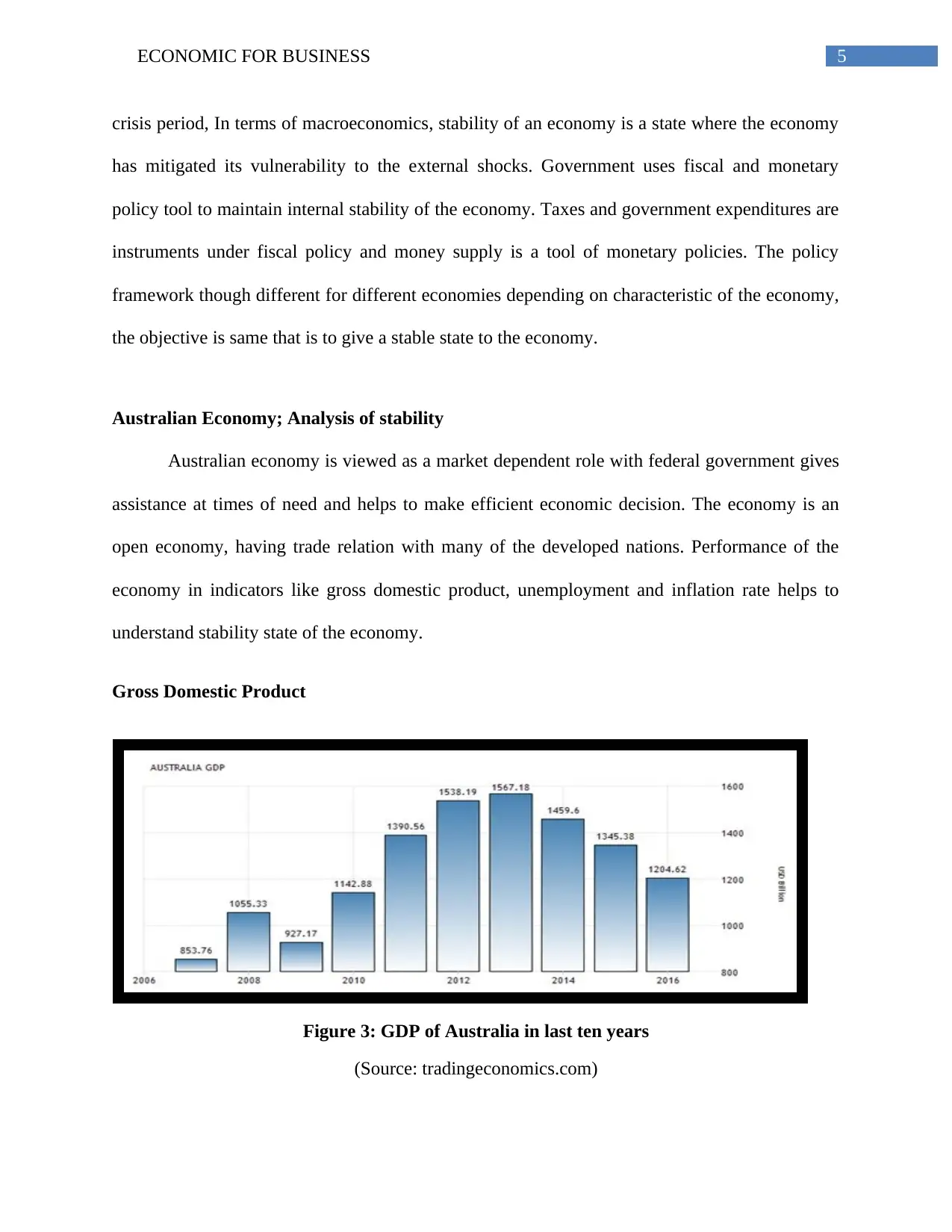
5ECONOMIC FOR BUSINESS
crisis period, In terms of macroeconomics, stability of an economy is a state where the economy
has mitigated its vulnerability to the external shocks. Government uses fiscal and monetary
policy tool to maintain internal stability of the economy. Taxes and government expenditures are
instruments under fiscal policy and money supply is a tool of monetary policies. The policy
framework though different for different economies depending on characteristic of the economy,
the objective is same that is to give a stable state to the economy.
Australian Economy; Analysis of stability
Australian economy is viewed as a market dependent role with federal government gives
assistance at times of need and helps to make efficient economic decision. The economy is an
open economy, having trade relation with many of the developed nations. Performance of the
economy in indicators like gross domestic product, unemployment and inflation rate helps to
understand stability state of the economy.
Gross Domestic Product
Figure 3: GDP of Australia in last ten years
(Source: tradingeconomics.com)
crisis period, In terms of macroeconomics, stability of an economy is a state where the economy
has mitigated its vulnerability to the external shocks. Government uses fiscal and monetary
policy tool to maintain internal stability of the economy. Taxes and government expenditures are
instruments under fiscal policy and money supply is a tool of monetary policies. The policy
framework though different for different economies depending on characteristic of the economy,
the objective is same that is to give a stable state to the economy.
Australian Economy; Analysis of stability
Australian economy is viewed as a market dependent role with federal government gives
assistance at times of need and helps to make efficient economic decision. The economy is an
open economy, having trade relation with many of the developed nations. Performance of the
economy in indicators like gross domestic product, unemployment and inflation rate helps to
understand stability state of the economy.
Gross Domestic Product
Figure 3: GDP of Australia in last ten years
(Source: tradingeconomics.com)
⊘ This is a preview!⊘
Do you want full access?
Subscribe today to unlock all pages.

Trusted by 1+ million students worldwide
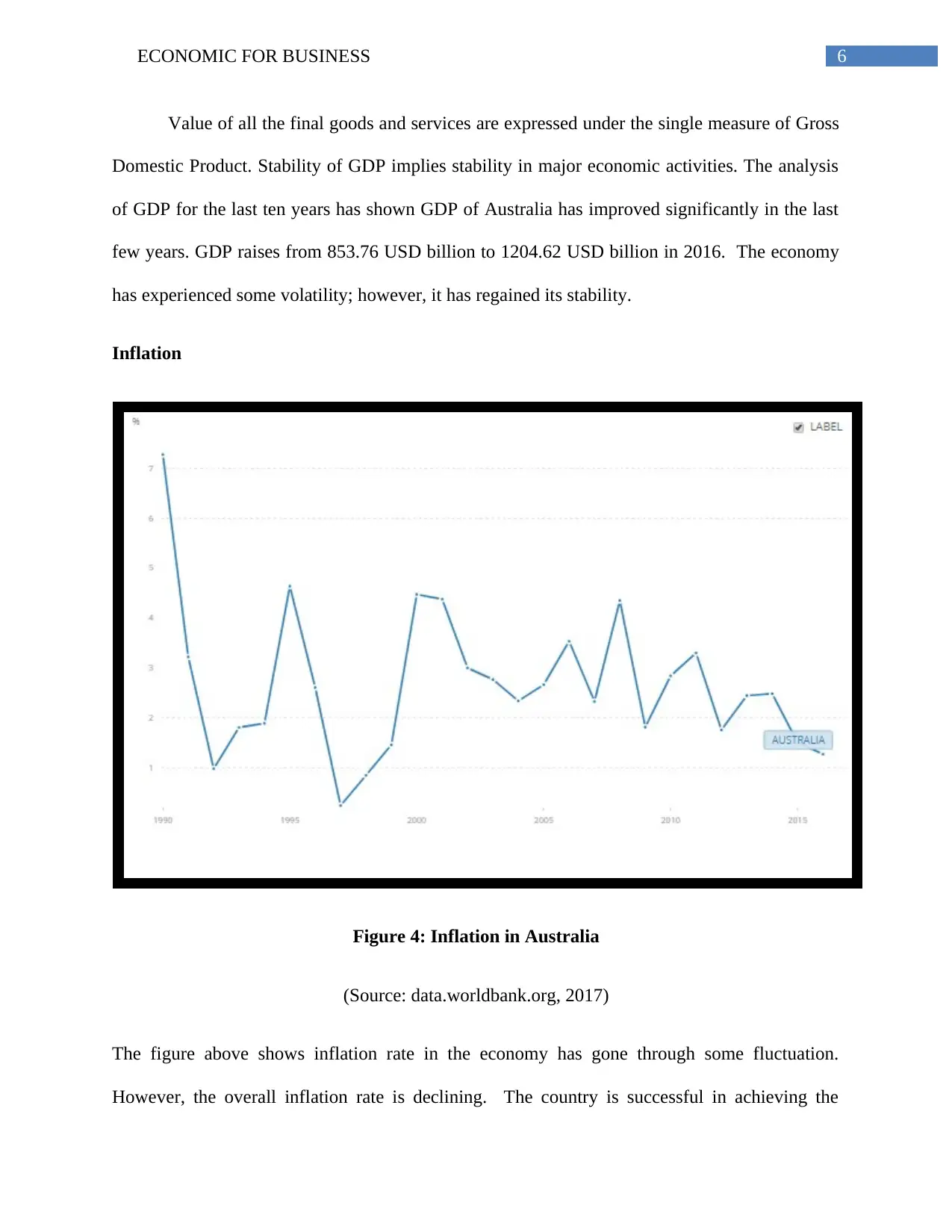
6ECONOMIC FOR BUSINESS
Value of all the final goods and services are expressed under the single measure of Gross
Domestic Product. Stability of GDP implies stability in major economic activities. The analysis
of GDP for the last ten years has shown GDP of Australia has improved significantly in the last
few years. GDP raises from 853.76 USD billion to 1204.62 USD billion in 2016. The economy
has experienced some volatility; however, it has regained its stability.
Inflation
Figure 4: Inflation in Australia
(Source: data.worldbank.org, 2017)
The figure above shows inflation rate in the economy has gone through some fluctuation.
However, the overall inflation rate is declining. The country is successful in achieving the
Value of all the final goods and services are expressed under the single measure of Gross
Domestic Product. Stability of GDP implies stability in major economic activities. The analysis
of GDP for the last ten years has shown GDP of Australia has improved significantly in the last
few years. GDP raises from 853.76 USD billion to 1204.62 USD billion in 2016. The economy
has experienced some volatility; however, it has regained its stability.
Inflation
Figure 4: Inflation in Australia
(Source: data.worldbank.org, 2017)
The figure above shows inflation rate in the economy has gone through some fluctuation.
However, the overall inflation rate is declining. The country is successful in achieving the
Paraphrase This Document
Need a fresh take? Get an instant paraphrase of this document with our AI Paraphraser
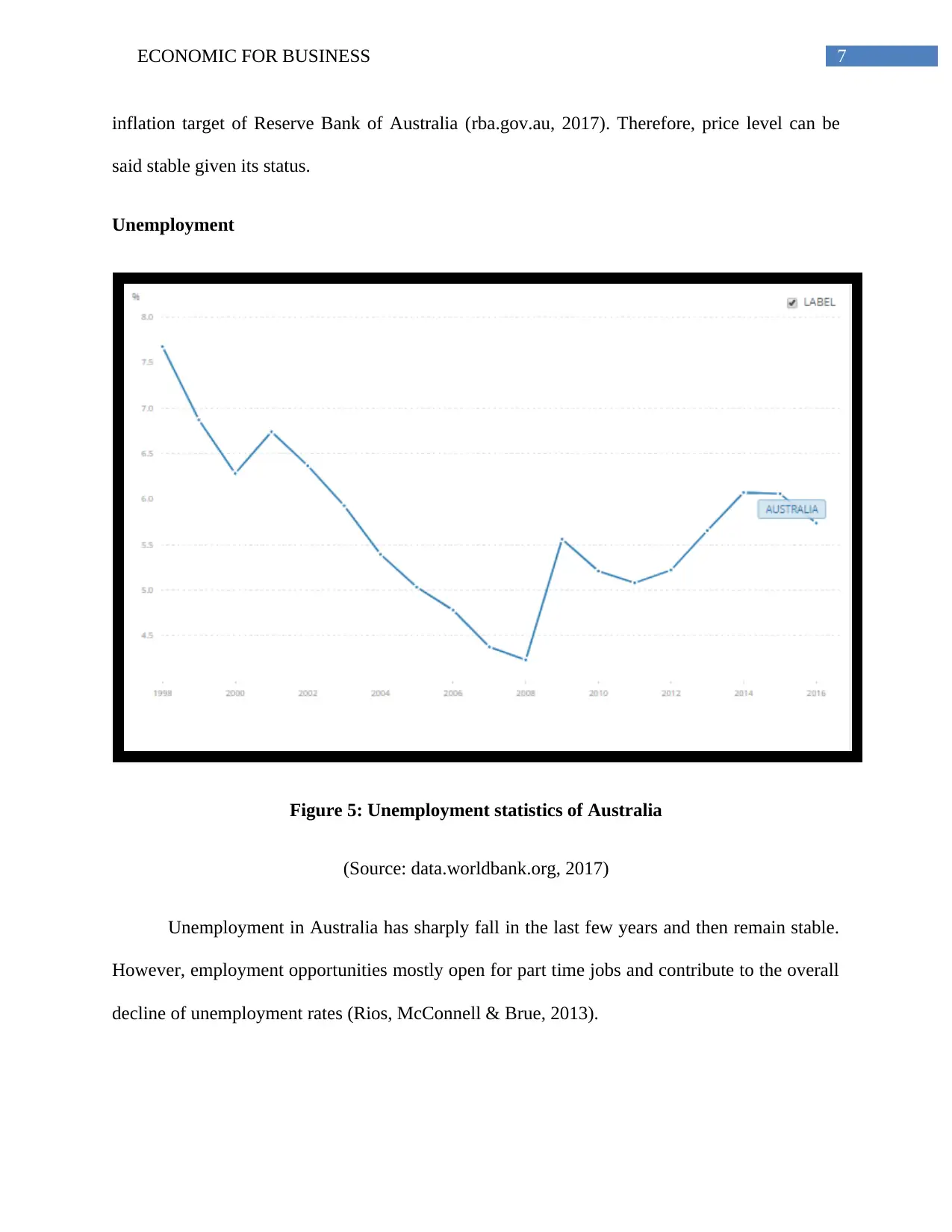
7ECONOMIC FOR BUSINESS
inflation target of Reserve Bank of Australia (rba.gov.au, 2017). Therefore, price level can be
said stable given its status.
Unemployment
Figure 5: Unemployment statistics of Australia
(Source: data.worldbank.org, 2017)
Unemployment in Australia has sharply fall in the last few years and then remain stable.
However, employment opportunities mostly open for part time jobs and contribute to the overall
decline of unemployment rates (Rios, McConnell & Brue, 2013).
inflation target of Reserve Bank of Australia (rba.gov.au, 2017). Therefore, price level can be
said stable given its status.
Unemployment
Figure 5: Unemployment statistics of Australia
(Source: data.worldbank.org, 2017)
Unemployment in Australia has sharply fall in the last few years and then remain stable.
However, employment opportunities mostly open for part time jobs and contribute to the overall
decline of unemployment rates (Rios, McConnell & Brue, 2013).
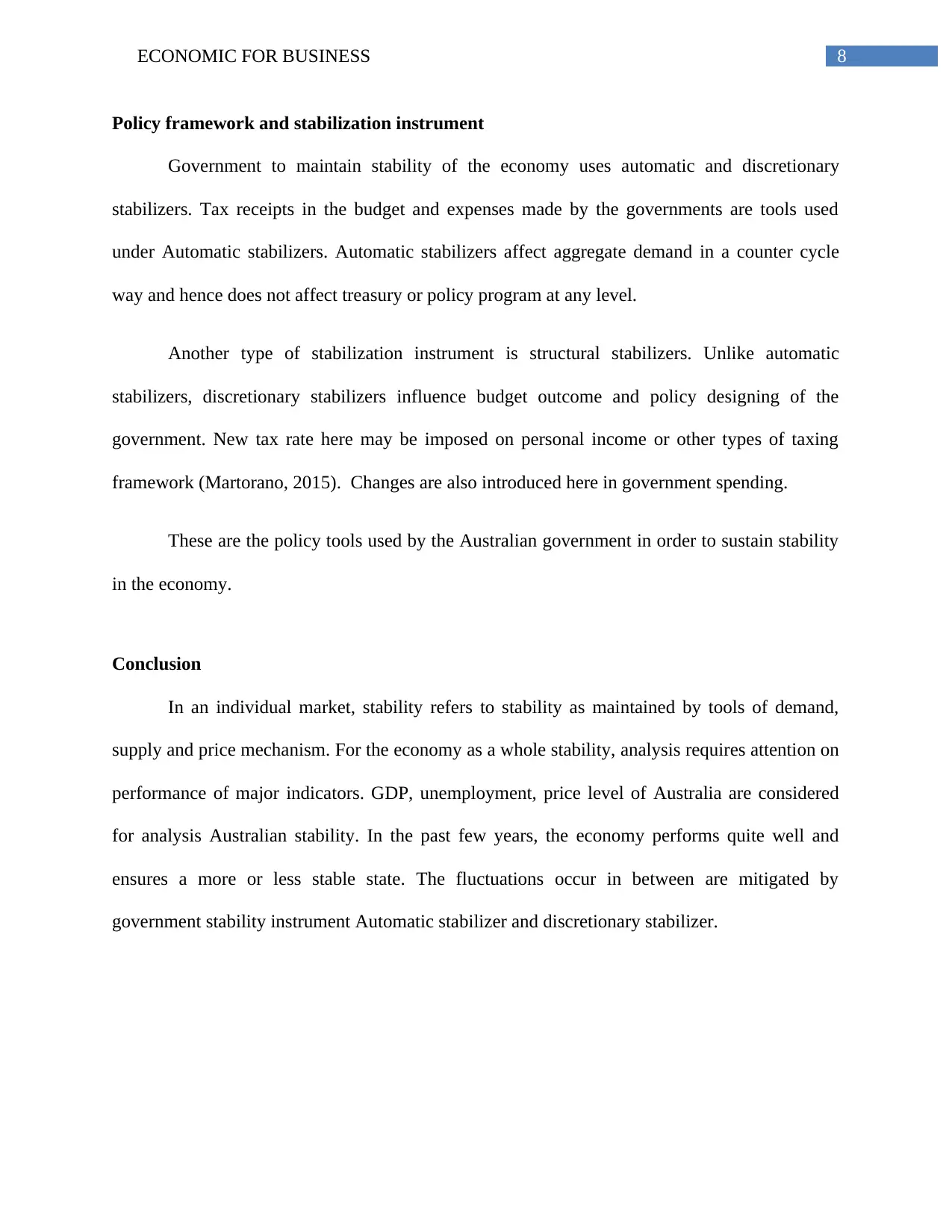
8ECONOMIC FOR BUSINESS
Policy framework and stabilization instrument
Government to maintain stability of the economy uses automatic and discretionary
stabilizers. Tax receipts in the budget and expenses made by the governments are tools used
under Automatic stabilizers. Automatic stabilizers affect aggregate demand in a counter cycle
way and hence does not affect treasury or policy program at any level.
Another type of stabilization instrument is structural stabilizers. Unlike automatic
stabilizers, discretionary stabilizers influence budget outcome and policy designing of the
government. New tax rate here may be imposed on personal income or other types of taxing
framework (Martorano, 2015). Changes are also introduced here in government spending.
These are the policy tools used by the Australian government in order to sustain stability
in the economy.
Conclusion
In an individual market, stability refers to stability as maintained by tools of demand,
supply and price mechanism. For the economy as a whole stability, analysis requires attention on
performance of major indicators. GDP, unemployment, price level of Australia are considered
for analysis Australian stability. In the past few years, the economy performs quite well and
ensures a more or less stable state. The fluctuations occur in between are mitigated by
government stability instrument Automatic stabilizer and discretionary stabilizer.
Policy framework and stabilization instrument
Government to maintain stability of the economy uses automatic and discretionary
stabilizers. Tax receipts in the budget and expenses made by the governments are tools used
under Automatic stabilizers. Automatic stabilizers affect aggregate demand in a counter cycle
way and hence does not affect treasury or policy program at any level.
Another type of stabilization instrument is structural stabilizers. Unlike automatic
stabilizers, discretionary stabilizers influence budget outcome and policy designing of the
government. New tax rate here may be imposed on personal income or other types of taxing
framework (Martorano, 2015). Changes are also introduced here in government spending.
These are the policy tools used by the Australian government in order to sustain stability
in the economy.
Conclusion
In an individual market, stability refers to stability as maintained by tools of demand,
supply and price mechanism. For the economy as a whole stability, analysis requires attention on
performance of major indicators. GDP, unemployment, price level of Australia are considered
for analysis Australian stability. In the past few years, the economy performs quite well and
ensures a more or less stable state. The fluctuations occur in between are mitigated by
government stability instrument Automatic stabilizer and discretionary stabilizer.
⊘ This is a preview!⊘
Do you want full access?
Subscribe today to unlock all pages.

Trusted by 1+ million students worldwide
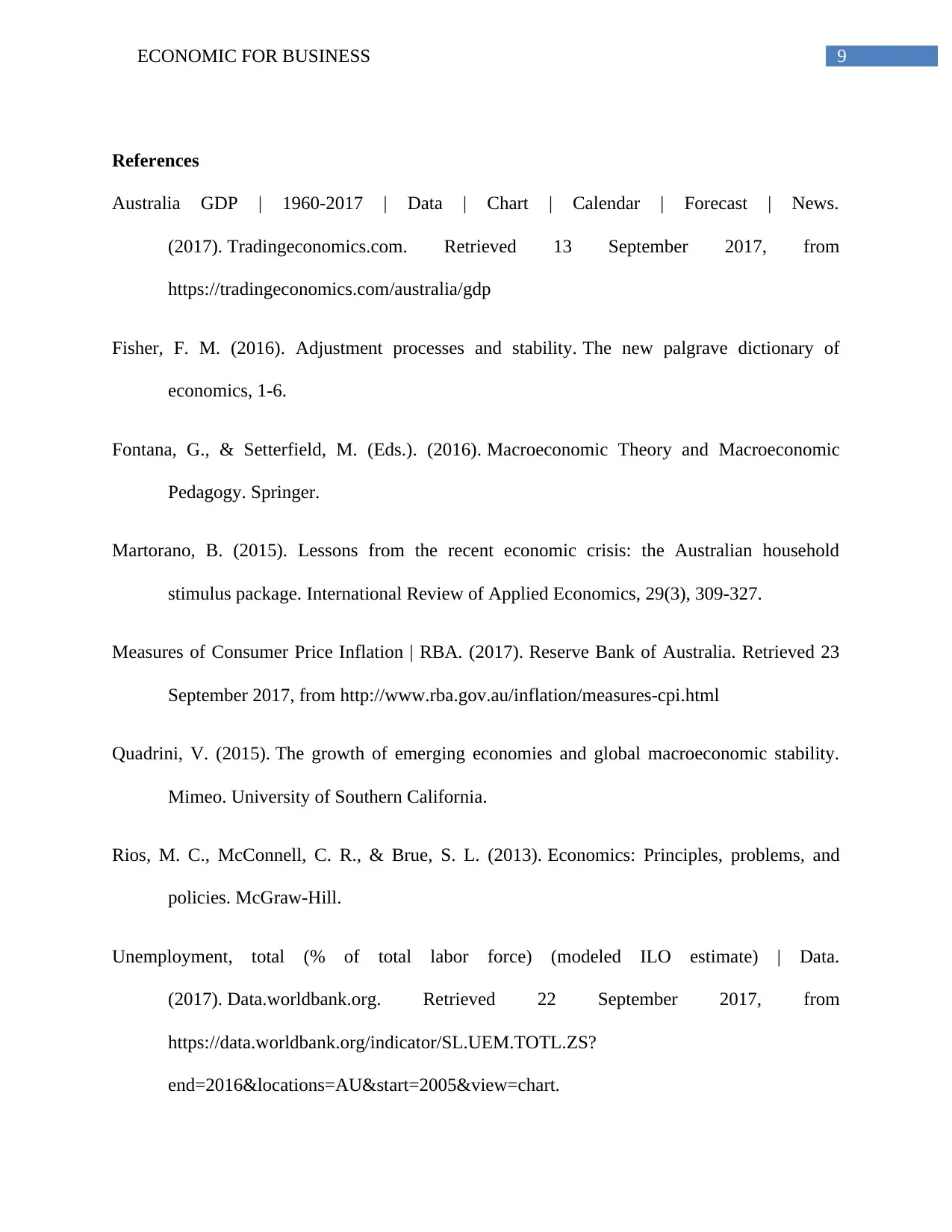
9ECONOMIC FOR BUSINESS
References
Australia GDP | 1960-2017 | Data | Chart | Calendar | Forecast | News.
(2017). Tradingeconomics.com. Retrieved 13 September 2017, from
https://tradingeconomics.com/australia/gdp
Fisher, F. M. (2016). Adjustment processes and stability. The new palgrave dictionary of
economics, 1-6.
Fontana, G., & Setterfield, M. (Eds.). (2016). Macroeconomic Theory and Macroeconomic
Pedagogy. Springer.
Martorano, B. (2015). Lessons from the recent economic crisis: the Australian household
stimulus package. International Review of Applied Economics, 29(3), 309-327.
Measures of Consumer Price Inflation | RBA. (2017). Reserve Bank of Australia. Retrieved 23
September 2017, from http://www.rba.gov.au/inflation/measures-cpi.html
Quadrini, V. (2015). The growth of emerging economies and global macroeconomic stability.
Mimeo. University of Southern California.
Rios, M. C., McConnell, C. R., & Brue, S. L. (2013). Economics: Principles, problems, and
policies. McGraw-Hill.
Unemployment, total (% of total labor force) (modeled ILO estimate) | Data.
(2017). Data.worldbank.org. Retrieved 22 September 2017, from
https://data.worldbank.org/indicator/SL.UEM.TOTL.ZS?
end=2016&locations=AU&start=2005&view=chart.
References
Australia GDP | 1960-2017 | Data | Chart | Calendar | Forecast | News.
(2017). Tradingeconomics.com. Retrieved 13 September 2017, from
https://tradingeconomics.com/australia/gdp
Fisher, F. M. (2016). Adjustment processes and stability. The new palgrave dictionary of
economics, 1-6.
Fontana, G., & Setterfield, M. (Eds.). (2016). Macroeconomic Theory and Macroeconomic
Pedagogy. Springer.
Martorano, B. (2015). Lessons from the recent economic crisis: the Australian household
stimulus package. International Review of Applied Economics, 29(3), 309-327.
Measures of Consumer Price Inflation | RBA. (2017). Reserve Bank of Australia. Retrieved 23
September 2017, from http://www.rba.gov.au/inflation/measures-cpi.html
Quadrini, V. (2015). The growth of emerging economies and global macroeconomic stability.
Mimeo. University of Southern California.
Rios, M. C., McConnell, C. R., & Brue, S. L. (2013). Economics: Principles, problems, and
policies. McGraw-Hill.
Unemployment, total (% of total labor force) (modeled ILO estimate) | Data.
(2017). Data.worldbank.org. Retrieved 22 September 2017, from
https://data.worldbank.org/indicator/SL.UEM.TOTL.ZS?
end=2016&locations=AU&start=2005&view=chart.
1 out of 10
Related Documents
Your All-in-One AI-Powered Toolkit for Academic Success.
+13062052269
info@desklib.com
Available 24*7 on WhatsApp / Email
![[object Object]](/_next/static/media/star-bottom.7253800d.svg)
Unlock your academic potential
Copyright © 2020–2025 A2Z Services. All Rights Reserved. Developed and managed by ZUCOL.





